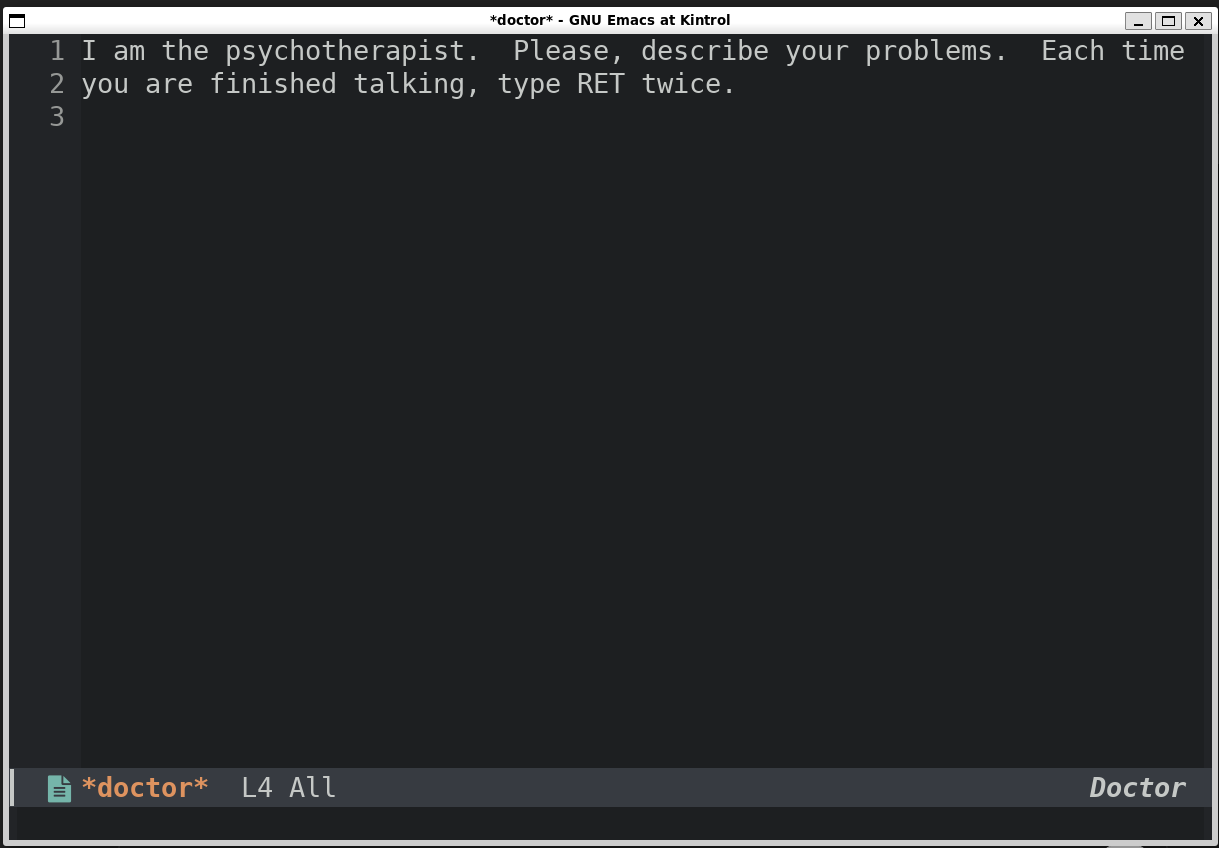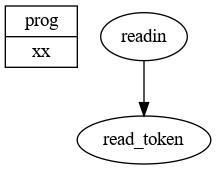如何写出 doctor.el*
Table of Contents
我一定能把它分析做完
目录: 梳理文档结构
- 1-28: LISP 文档标准格式
- 1-22
- 1-2: 简介
- 3-4: 版权
- 5-7: 维护
- 10-22: GNU 协议
- 23-28 Comm
- 1-22
- 29-30: Code
- 31-113: 初始化变量 (defavr …)
- -540
- 548-817: (doctor-put-meaning … '…)
- 818-858:
- 859-927: [;; Main processing function for sentences that have been read.]
- 928-1348: 定义语法词汇函数[;; Things done to process sentences once read.]
- -1348
- 1349-1402: 定义合成回复函数 [;; Output of replies.]
- 1403-1621: 定义特定话题 [;; Functions that handle specific words or meanings when found.] (defun doctor-zippy () 1596-1597 注释
- 1624-1626: 结束
需要认识词汇(有一定话题可聊)
流程上分析:
- 标准输出
- 接受输入
- 处理识别
- 分析回复
- 循环进行
打开时显示

I am the psychotherapist. Please, describe your problems. Each time you are finished talking, type RET twice.
这是
(define-derived-mode doctor-mode text-mode "Doctor" "Major mode for running the Doctor (Eliza) program. Like Text mode with Auto Fill mode except that RET when point is after a newline, or LFD at any time, reads the sentence before point, and prints the Doctor's answer." :interactive nil (doctor-make-variables) (turn-on-auto-fill) (doctor-type '(i am the psychotherapist \. (doc$ doctor--please) (doc$ doctor--describe) your (doc$ doctor--problems) \. each time you are finished talking\, type \R\E\T twice \.)) (insert "\n"))
生成的
1. 前置知识
我自己并不了解 Emacs 里面一些函数,这里正好统一收集整理。
- 不加引用(‘)是对象,可能是原子、变量
- 加引用’是对象的值,比如想要让 C-z 运行 undo 函数
(global-set-key (kbd "C-z") 'undo)
'就像是(一个指针)把对象的地址作为参数传了过去。一般这样称为绑定,lisp 所谓表处理,就是在不断地求值,值是一种表示(这理由好比是所有的对象存在一张哈希表,一个对象对应一个值),不过程序代码是无法操作的(不像 C 把列表地址加一就是下一个元素了)。
当然只有绑定了的符号才有值,比如初始化未指定的变量就没值(nil)。 大部分定义的对象的值是本身,比如函数就是内部代码的值,列表也是; 而符号的值是绑定的对象(所谓符号,就是比如字符串 my-list 这样的符号;), 宏 macro 的值是(代码)展开形式,缓冲区和窗口也不是自身。
函数
- defvar: 和 setq 区别: defvar 用于全局变量,一般文档开始大量使用,便于阅读(约定俗成的行为),再次定义相同符号不改值(会警告),setq 无条件设置任何值(再次赋值相同符号就会更新)
- defun: 经典 LISP 函数,用来定函数
- defmacro: 利用已有函数
define
define-derived-mode
doc// 函数不明白,难道是换行用?
2. 宏与函数
doc$ 和 doctor-$
(defmacro doc$ (what)
"Quoted arg form of `doctor-$'."
`(doctor-$ ',what))
(defun doctor-$ (what)
"Return the car of a list, rotating the list each time."
(let* ((vv (symbol-value what))
(first (car vv))
(ww (append (cdr vv) (list first))))
(set what ww)
first))
量我见识短浅,这里的代码还是颇为巧妙。 核心功能是获得列表的第一个元素,然后将列表这个元素放最后。 而为了有时候需要不改变表,额外定义了(相当于条件复杂效果更精巧)的 doc$ 这时传入的参数(实际上是表的值)不会被改变
下面是一个更具体分析: 这个函数的作用是返回一个列表的第一个元素,并且将列表中的元素循环移动,使得下一次调用时返回的是原列表中的下一个元素。
doc-$
- (defmacro doc$ (what) …):这行代码定义了一个名为 doc$ 的宏,它接受一个参数 what。
- "Quoted arg form of 'doctor-$'.":这是对这个宏的简短文档说明,说明了宏的作用。
- `(doctor-$ ',what)):这是宏的主体部分。在这里,`(反引号)用于引用代码,,(逗号)用于在宏中插入参数值。所以 (doctor-$ ',what) 这部分代码的作用是生成调用 doctor-$ 函数的代码,其中参数 what 被引用了进去,并且在引用时被加上了单引号 ',这样它就成了一个被引用的列表。
总结起来,这个宏的作用就是生成调用 doctor-$ 函数的代码,并且将传入的参数作为引用加入到生成的代码中。
为什么不能每次直接使用 doctor-$ 呢? 方便引用,类比 set 与 setq 关系。 使用宏还可以避免在每次调用时都手动加上引号
3. 缓冲准备
用了 defvar-keymap 绑定两个函数, 这里值得注意的是加了#,GPT说这是约定俗成,一般后面调用是函数或宏就加#以示区分
继续定义基本的 buffer 内容
- 定义了一个 major mode,名为 "Doctor"。
- 设置了 mode-line 的显示为 "Doctor"。
- 提供了一个简要的描述,说明这个 major mode 是用于运行 Doctor (Eliza) 程序的。
- 禁止了用户直接调用这个 mode 的命令(:interactive nil)。
- 调用了 doctor-make-variables 函数,用于初始化一些相关的变量。
- 打开了自动换行(Auto Fill)模式。
- 调用了 doctor-type 函数,这个函数用于模拟用户的输入,每次输入一句话给 Doctor,然后打印 Doctor 的回答。
- 最后,在缓冲区中插入一个空行。
函数 defun doctor-make-variables
用了 setq-local 可能只在运行时创建的变量
这里有一个纠错机制
问了GPT,给了一个 dolist 写法,据说减少了遍历次数
在进行纠错和全名部分的处理时,我会建议使用一个更简洁和高效的方法来实现。以下是一个可能的最佳实践:
elisp
Copy code
(defvar doctor--typos
'((theyll . ("they'll" . "they will"))
(don7t . ("don't" . "do not"))
(you7re . ("you're" . "i am"))
(you7ll . ("you'll" . "i will"))))
(defun doctor-make-variables ()
(dolist (typo doctor--typos)
(let ((spelltypo (car typo))
(correction (car (cdr (cdr typo))))
(expansion (cdr (cdr typo))))
(put spelltypo 'doctor-correction correction)
(put spelltypo 'doctor-expansion expansion)))
下面是几段套话,具体来说是给了一些话题用词,看到这个不由得让人想起初中口语话题集,现在的 IELTS 话题。看来 AI 也要话题词汇积累嘿
仔细看还有特别之处,比如
(setq-local doctor--famlst
'((tell me (doc$ doctor--something) about (doc// doctor-owner) family \.)
(you seem to dwell on (doc// doctor-owner) family \.)
((doc$ doctor--areyou) hung up on (doc// doctor-owner) family \?)))
变量定义在 316
(setq-local doctor--something '((something)
(more)
(how you feel)))
这个语言组合游戏于是内部又可以组合(可以找找有没有你中有我我中有你的情况) 不过还用到了开篇定义的宏 doc$ ,增加语言多样性(我以为多样性可以用概率,可能随机选对纯列表 lisp 压力大一些)
也不知道怎么保证不会有几个词撞在一起出现不成句子的情况(难道编程序的“语言学家”提前订好了词性结构)
一路到539
4. 相关话题列表
(defun doctor-meaning (x) (get x 'doctor-meaning)) (defmacro doctor-put-meaning (symb val) "Store the base meaning of a word on the property list." `(put ',symb 'doctor-meaning ,val))
现在是把那些词对应那些话题给了出来,
我很不喜欢相似的内容不是相似的格式,如果是我写代码,一定会把上面话题类型的 setq-local 单独领出来
而且很不好的是似乎他把函数和属性都命名为 doctor-meaning (居然用 meaning)
一路到达817
居然在 819 出现,也不知道是不是惯例,淡厮乎这样太不方便吧,这属于基本的内容应该放在定义buffer 附近。 好的,我宣布上面的话果然是小白的话
因为这里出现了一个小东西
5. 心理咨询正式开始
;;;###autoload
(defun doctor ()
"Switch to *doctor* buffer and start giving psychotherapy."
(interactive)
(switch-to-buffer "*doctor*")
(doctor-mode))
(defun doctor-ret-or-read (arg)
"Insert a newline if preceding character is not a newline.
Otherwise call the Doctor to parse preceding sentence."
(interactive "*p" doctor-mode)
(if (= (preceding-char) ?\n)
(doctor-read-print)
(newline arg)))
这个818行的代码特别之处 ;###autoload 注释标记某些函数或宏,那么在加载文件时,Emacs 会记住这些标记,并在需要时自动加载相应的函数或宏。
类比就像之前的代码是医生的基础知识,现在进入正式环节
首先是819打开 doctor buffer,开启 132 定义的 doctor-mode; 接着 doctor-ret-or-read 检测前一个字符是否是换行符,是的话就调用下面的
(defun doctor-read-print ()
"Top level loop."
(interactive nil doctor-mode)
(setq doctor-sent (doctor-readin))
(insert "\n")
(setq doctor--lincount (1+ doctor--lincount))
(doctor-doc)
(insert "\n")
(setq doctor--bak doctor-sent))
(defun doctor-readin ()
"Read a sentence. Return it as a list of words."
(let (sentence)
(backward-sentence 1)
(while (not (eobp))
(setq sentence (append sentence (list (doctor-read-token)))))
sentence))
(defun doctor-read-token ()
"Read one word from buffer."
(prog1 (intern (downcase (buffer-substring (point)
(progn
(forward-word 1)
(point)))))
(re-search-forward "\\Sw*")))
这三个函数可以反过来解释
- read-token 很奇怪,功能是:
把前一个词赋予一个变量存下来, (用的 intern :保证原来如果没有就用这个,有了就新建) 移动到下一个词
- doctor-readin 利用 -read-token 是一个把前一个句子分解成单词列表的函数,返回列表。
(看起来只能读一个句子)
- doctor-read-print (被回车触发)调用 -readin 得到列表, 赋值给变量 doctor-sent,换行加1到行数记录变量 –lincount
1449,1454 用到 doctor–lincount 不知道作用是什么 同时还备份一个回复到变量 doctor–bak 核心部分调用接下来的 doctor-doc

可见,整个 doctoc 就是被 doctor-read-print 调控,它相当于 main 函数了。
6. 核心分类
下面 doctor-doc 详细给出如何处理接收到的用户输入 (不能用指针传参只能全局真不爽)
(defun doctor-doc ()
(cond
((equal doctor-sent '(foo))
(doctor-type '(bar! (doc$ doctor--please) (doc$ doctor--continue) \.)))
((member doctor-sent doctor--howareyoulst)
(doctor-type '(i\'m ok \. (doc$ doctor--describe) yourself \.)))
((or (member doctor-sent '((good bye) (see you later) (i quit) (so long)
(go away) (get lost)))
(memq (car doctor-sent)
'(bye halt break quit done exit goodbye
bye\, stop pause goodbye\, stop pause)))
(doctor-type (doc$ doctor--bye)))
((and (eq (car doctor-sent) 'you)
(memq (cadr doctor-sent) doctor--abusewords))
(setq doctor-found (cadr doctor-sent))
(doctor-type (doc$ doctor--abuselst)))
((eq (car doctor-sent) 'whatmeans)
(doctor-def (cadr doctor-sent)))
((equal doctor-sent '(parse))
(doctor-type (list 'subj '= doctor-subj ", "
'verb '= doctor-verb "\n"
'object 'phrase '= doctor-obj ","
'noun 'form '= doctor-object "\n"
'current 'keyword 'is doctor-found
", "
'most 'recent 'possessive
'is doctor-owner "\n"
'sentence 'used 'was
"..."
'(doc// doctor--bak))))
((memq (car doctor-sent) '(are is do has have how when where who why))
(doctor-type (doc$ doctor--qlist)))
;; ((eq (car sent) 'forget)
;; (set (cadr sent) nil)
;; (doctor-type '((doc$ doctor--isee) (doc$ doctor--please)
;; (doc$ doctor--continue)\.)))
(t
(if (doctor-defq doctor-sent) (doctor-define doctor-sent doctor-found))
(if (> (length doctor-sent) 12)
(setq doctor-sent (doctor-shorten doctor-sent)))
(setq doctor-sent (doctor-correct-spelling
(doctor-replace doctor-sent doctor--replist)))
(cond ((and (not (memq 'me doctor-sent)) (not (memq 'i doctor-sent))
(memq 'am doctor-sent))
(setq doctor-sent (doctor-replace doctor-sent '((am . (are)))))))
(cond ((equal (car doctor-sent) 'yow) (doctor-zippy))
((< (length doctor-sent) 2)
(cond ((eq (doctor-meaning (car doctor-sent)) 'howdy)
(doctor-howdy))
(t (doctor-short))))
(t
(if (memq 'am doctor-sent)
(setq doctor-sent (doctor-replace doctor-sent '((me . (i))))))
(setq doctor-sent (doctor-fixup doctor-sent))
(if (and (eq (car doctor-sent) 'do) (eq (cadr doctor-sent) 'not))
(cond ((zerop (random 3))
(doctor-type '(are you (doc$ doctor--afraidof) that \?)))
((zerop (random 2))
(doctor-type '(don\'t tell me what to do \. i am the
doctor here!))
(doctor-rthing))
(t
(doctor-type '((doc$ doctor--whysay) that i shouldn\'t
(cddr doctor-sent)
\?))))
(doctor-go (doctor-wherego doctor-sent))))))))
又是一个结构我看起来十分混乱的函数,不明白为什么不把回复的特定组合存起来,难道节省空间?
?– 表; - 函数、变量
满足任何一个就回复
- foo
- howareyou -> 回复 我好 –describe
- 检查告别 -> 回复 –bye
- 侮辱 -> 回复 -abuselst
- whatmean 含义 -> 回复 -def
- parse
- 一般疑问
- t 默认
- 看有无可以解答 defq->define
- 缩句
- 替换?
- 如果没有 i me 将 am 换成 are
- 判断;
- 以 "yow" 开头 -> zippy
- 少于两个词:
- 取首词检验 是 howdy -> howdy
- 否:短句回应
- 一般
- 有 "am" :将 me 换成 i
- -fixup
- 开头是 "do not"
- -go
7. 具体函数
基本句子操作:拼写、缩短 [930-954]
(defun doctor-correct-spelling (sent)
"Correct the spelling and expand each word in sentence."
(if sent
(apply 'append (mapcar (lambda (word)
(if (memq word doctor--typos)
(get (get word 'doctor-correction)
'doctor-expansion)
(list word)))
sent))))
(defun doctor-shorten (sent)
"Make a sentence manageably short using a few hacks."
(let (foo
(retval sent)
(temp '(because but however besides anyway until
while that except why how)))
(while temp
(setq foo (memq (car temp) sent))
(if (and foo
(> (length foo) 3))
(setq retval (doctor-fixup foo)
temp nil)
(setq temp (cdr temp))))
retval))
拼写纠错: 利用 typo 表
缩短原理: ?扔掉连接词
医生一些行为
解释含义
(defun doctor-define (sent found)
(doctor-svo sent found 1 nil)
(and
(doctor-nounp doctor-subj)
(not (doctor-pronounp doctor-subj))
doctor-subj
(doctor-meaning doctor-object)
(put doctor-subj 'doctor-meaning (doctor-meaning doctor-object))
t))
(defun doctor-defq (sent)
"Set global var DOCTOR-FOUND to first keyword found in sentence SENT."
(setq doctor-found nil)
(let ((temp '(means applies mean refers refer related
similar defined associated linked like same)))
(while temp
(if (memq (car temp) sent)
(setq doctor-found (car temp)
temp nil)
(setq temp (cdr temp)))))
doctor-found)
(defun doctor-def (x)
(doctor-type (list 'the 'word x 'means (doctor-meaning x) 'to 'me))
nil)
(defun doctor-forget ()
"Delete the last element of the history list."
(setq doctor--history (reverse (cdr (reverse doctor--history)))))
(defun doctor-query (x)
"Prompt for a line of input from the minibuffer until a noun or verb is seen.
Put dialogue in buffer."
(let (a
(prompt (concat (doctor-make-string x)
" what ? "))
retval)
(while (not retval)
(while (not a)
(insert ?\n
prompt
(read-string prompt)
?\n)
(setq a (doctor-readin)))
(while (and a (not retval))
(cond ((doctor-nounp (car a))
(setq retval (car a)))
((doctor-verbp (car a))
(setq retval (doctor-build
(doctor-build x " ")
(car a))))
((setq a (cdr a))))))
retval))
defq 是一个查找函数,将全局 DOCTOR-FOUND 作为状态量。 查找是否有 temp 列表中的词 (means applies mean refers refer related similar defined associated linked like same) 如果有,就用 define 造句。
doctor-go 很有意思,假如没有
遗忘
8. 语法
(defun doctor-subjsearch (sent key type)
"Search for the subject of a sentence SENT, looking for the noun closest
to and preceding KEY by at least TYPE words. Set global variable `doctor-subj'
to the subject noun, and return the portion of the sentence following it."
(let ((i (- (length sent) (length (memq key sent)) type)))
(while (and (> i -1) (not (doctor-nounp (nth i sent))))
(setq i (1- i)))
(cond ((> i -1)
(setq doctor-subj (nth i sent))
(nthcdr (1+ i) sent))
(t
(setq doctor-subj 'you)
nil))))
(defun doctor-nounp (x)
"Return non-nil if the symbol argument is a noun."
(or (doctor-pronounp x)
(not (or (doctor-verbp x)
(equal x 'not)
(doctor-prepp x)
(doctor-modifierp x) )) ))
(defun doctor-pronounp (x)
"Return non-nil if the symbol argument is a pronoun."
(memq x '(
i me mine myself
we us ours ourselves ourself
you yours yourself yourselves
he him himself she hers herself
it that those this these things thing
they them themselves theirs
anybody everybody somebody
anyone everyone someone
anything something everything)))
(dolist (x
'(abort aborted aborts ask asked asks am
applied applies apply are associate
...
write writes writing wrote use used uses using))
(put x 'doctor-sentence-type 'verb))
(defun doctor-verbp (x) (if (symbolp x)
(eq (get x 'doctor-sentence-type) 'verb)))
(defun doctor-plural (x)
"Form the plural of the word argument."
(let ((foo (doctor-make-string x)))
(cond ((string-equal (substring foo -1) "s")
(cond ((string-equal (substring foo -2 -1) "s")
(intern (concat foo "es")))
(t x)))
((string-equal (substring foo -1) "y")
(intern (concat (substring foo 0 -1)
"ies")))
(t (intern (concat foo "s"))))))
(defun doctor-setprep (sent key)
(let ((val)
(foo (memq key sent)))
(cond ((doctor-prepp (cadr foo))
(setq val (doctor-getnoun (cddr foo)))
(cond (val val)
(t 'something)))
((doctor-articlep (cadr foo))
(setq val (doctor-getnoun (cddr foo)))
(cond (val (doctor-build (doctor-build (cadr foo) " ") val))
(t 'something)))
(t 'something))))
(defun doctor-getnoun (x)
(cond ((null x) (setq doctor-object 'something))
((atom x) (setq doctor-object x))
((eq (length x) 1)
(setq doctor-object (cond
((doctor-nounp (setq doctor-object (car x))) doctor-object)
(t (doctor-query doctor-object)))))
((eq (car x) 'to)
(doctor-build 'to\ (doctor-getnoun (cdr x))))
((doctor-prepp (car x))
(doctor-getnoun (cdr x)))
((not (doctor-nounp (car x)))
(doctor-build (doctor-build (cdr (assq (car x)
(append
'((a . this)
(some . this)
(one . that))
(list
(cons
(car x) (car x))))))
" ")
(doctor-getnoun (cdr x))))
(t (setq doctor-object (car x))
(doctor-build (doctor-build (car x) " ") (doctor-getnoun (cdr x))))
))
1044 dolist
下面的函数的确奇怪, 用 memp 检查是否有检查输入里是否有参考表里面, 为什么要写一个函数,而不是直接定义一个通用查找函数和各类参考列表呢? ?电脑内存
搜索参考表函数有:
- articlep: the a an
- nmbrp
- colorp
- sizep
- possesiveprounp
- othermodifierp
- prepp 介词
- [1294] vowlp 元音
-remember
-type 使用 1351 的
-fixup 将反身人称代词 语气词
-fix-2
doctor-replace: [1297] 替换表有的换掉没有的保留(可能代码写的复杂了?)
-wherego
-svo
9. 打出回复
-txtype
-type-symbol
应该将 sent 改为 receive
另外我以前对于 require 和 provide 也弄错了,我以为的 require 是 load 的功能
语法和句子结构开始上线了 构成复数形式
医生的关键察觉( attenion !) 用了 memq (应该放后面不要混在语法一起)
svo!
注意到一个缩短句子的函数,注释说 hack
好奇点: 如何拼成句子,关键在于有多少模板,它的上限在哪? 记忆是如何实现的? 假如希望改进,如何让医生诱导交互,让用户输入医生知道的领域的内容,而不是仅仅检查用户在说啥(大部分情况可能医生无从应对)
10. 百变医生
奇怪的 defun
11. 研究
在知道了它能聊这些,针对性问,看是不是有这样的意思。
分析是否达到一个心理医生的水平:大概没有
问题: 重复性太高,所以很无趣,能谈的很少,限制性强;换一当年开发者个就是一个想到一个写一个,这很局限很大没意思,不过给了自生成一个思路。
提到语句生成和 ELIZA 相像,可以去看看分析一下。
12. 设想
首先我们考虑基于英语的对话,能不能让程序是在一个词典上运行的,开始词典内单词很少,比如只有hello,之后和我对话或者我引入一些同义词,使用内部的函数达到认识更多词语,了解更多环境(关于环境可以额外再有一个文档存储想象力部分的资料)比如parents,father。。是family,这和house,living有关系等;于是,建立在一个不断变大的(类似数据库的)词典上的程序可以对话边智能
我注意到,这个词典可能像是现代的数据库,不同元素之间会有复杂的联系,这一点如何记录比较好。如一个单词,它和什么词常常一起出现甚至前后组词,它和什么词同义可以替换。我可以使用什么样的存储词典呢,如果lisp很难实现,可以用python适合的体系,txt?json,yaml?